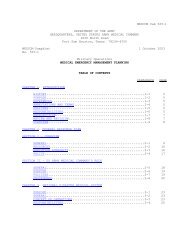(MCD) Guidelines
(MCD) Guidelines
(MCD) Guidelines
Create successful ePaper yourself
Turn your PDF publications into a flip-book with our unique Google optimized e-Paper software.
<strong>Guidelines</strong> for Military Mass Casualty Decontamination Operations<br />
During a Domestic HAZMAT/Weapon of Mass Destruction Incident<br />
Decontamination<br />
Solution<br />
M291 Skin<br />
Decontamination Kit<br />
Description<br />
Contains a finger-sized pad that is saturated with a carbon-based adsorbent<br />
and ion exchange resins. This powder is highly effective for skin decontamination,<br />
is non-toxic and non-irritating, and can be applied directly to the face<br />
and around wounds. The black powder also shows the areas that have and<br />
have not been decontaminated because of the resulting color contrast. The<br />
military typically uses this kit in the immediate/emergency decontamination<br />
process, but water has been shown to be more effective for some<br />
contamination. 13,15<br />
Aqueous Film Do not use this product in any casualty decontamination situation because it<br />
Forming Foam is known to be a skin and eye irritant. 49<br />
Sanitizing and/or Can be used to begin to remove liquid or solid contamination from a<br />
Baby Wipes casualty’s skin. This applies particularly during cold weather conditions and<br />
after gross decontamination while waiting for the mass decontamination line<br />
to be established. The sanitizing wipe could be effective against biological<br />
agents.<br />
Reactive Skin A commercially available product that can be used to aid in decontamination<br />
Decontamination operations. Reactive skin decontamination lotion is highly effective against<br />
Lotion<br />
chemical agents, and can neutralize the effects of many agents. 13 However, it<br />
is more expensive than soap and can be difficult to distribute to a large number<br />
of casualties. To use, open the individually-wrapped packet and blot the<br />
lotion onto visible spot contamination to begin neutralization. The reactive<br />
skin decontamination lotion can be used for the decontamination of intact skin<br />
around wounds, but is not approved for the decontamination of wounds. 13<br />
Bleach Can irritate the skin and open pores, so it is generally not recommended for<br />
use as a casualty decontaminant. If necessary, only a 0.5% solution should<br />
be used. 15 It is effective for the removal of chemical and biological agents, but<br />
not for radioactive agents. 13 Bleach reacts with a riot control agent to form a<br />
strong irritant, 50 so do not decontaminate riot control agents with any form of<br />
bleach. 51 The nerve agent Tabun (GA) may react to form cyanogen chloride<br />
(CK) in a bleach slurry. 52 A bleach and water solution may be used in the<br />
technical decontamination line for cleaning equipment and PPE. Full strength<br />
(5%) bleach can be used to decontaminate equipment such as litters or<br />
shears, but the equipment should always be rinsed thoroughly before it is<br />
reused. Bleach requires sufficient contact time with agent for complete<br />
neutralization, which depends on the agent, ambient temperature, and<br />
concentration of the bleach. Ensure time has elapsed so that complete<br />
neutralization occurs. 13<br />
Peroxides Are strong oxidizers and are highly reactive. While they may be effective at<br />
neutralizing contaminants, the break-down reaction can be violent and<br />
produce heat. The use of peroxide-containing solutions for casualty decontamination<br />
is not recommended, but it is recommended for the decontamination<br />
of equipment, facilities (furniture, walls, and doors, etc), and terrain. 13<br />
Caution is recommended if peroxide-based solutions are used during the<br />
technical decontamination process.<br />
30 Original



